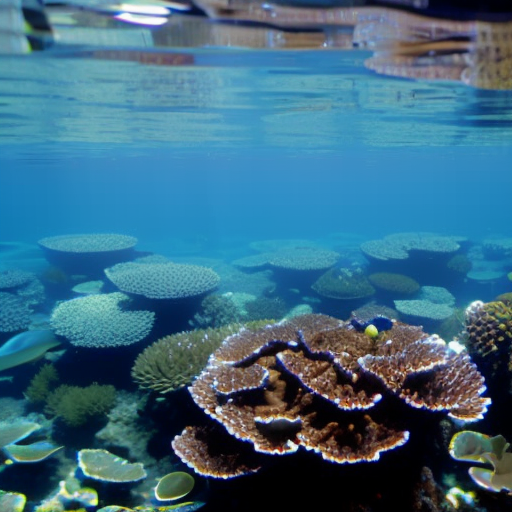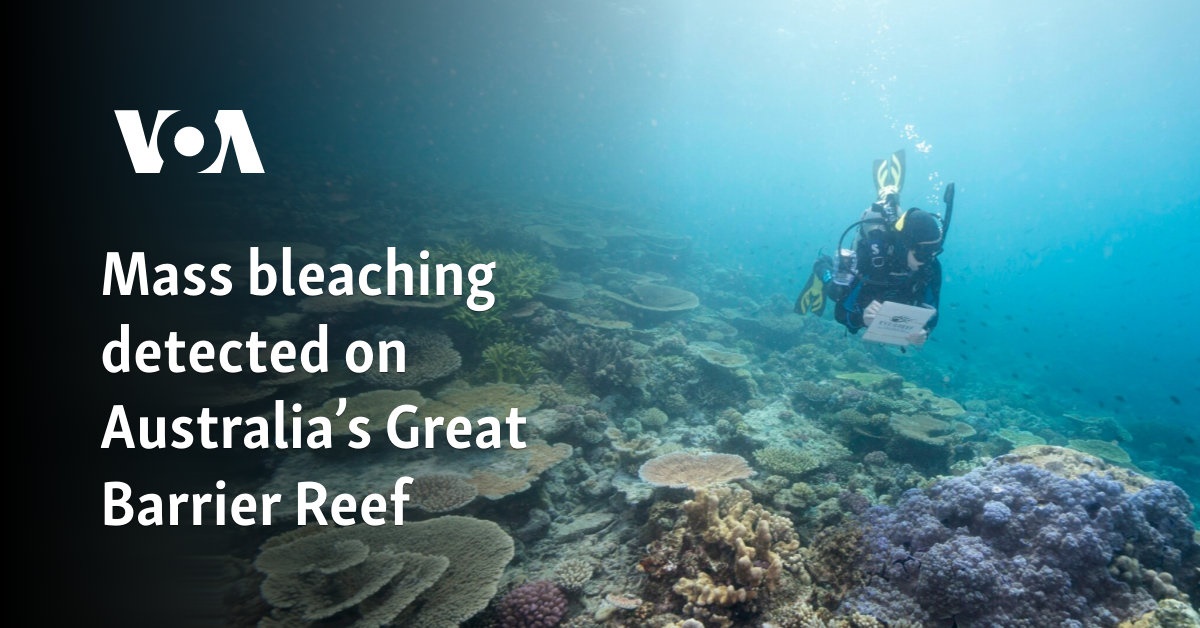Mass bleaching detected on Australia’s Great Barrier Reef
Mass bleaching detected on Australia’s Great Barrier Reef Voice of America - VOA News


Vast Areas of Australia’s Great Barrier Reef Affected by Coral Bleaching
Sustainable Development Goals (SDGs)
- Goal 13: Climate Action
- Goal 14: Life Below Water

Surveys have shown major bleaching is occurring along the 2,300-kilometer ecosystem.
The Great Barrier Reef, the world’s biggest coral system located in Australia, has been significantly affected by mass coral bleaching caused by a marine heatwave. Recent aerial surveillance carried out by the Great Barrier Reef Marine Park Authority and the Australian Institute of Marine Science revealed that 75 percent of the 1,001 inspected reefs contain bleached corals, indicating that the organisms residing on them are struggling to survive. A quarter of the surveyed individual reefs recorded low to no levels of bleaching, while half had high or very high levels.
Impact on Sustainable Development Goals (SDGs)
- Goal 13: Climate Action – The mass bleaching event on the Great Barrier Reef highlights the urgent need for climate action to mitigate the effects of global warming and protect marine ecosystems.
- Goal 14: Life Below Water – The bleaching of corals threatens the biodiversity and health of marine life, emphasizing the importance of preserving and restoring marine ecosystems.
The Great Barrier Reef Marine Park Authority confirmed “widespread bleaching across all three regions of the marine park” – its north, south, and central sectors. The sea surface temperatures remain 0.5-1.5 degrees above average for this time of year, contributing to the bleaching phenomenon.
Corals bleach, or turn white, when they are stressed by changes in water temperature, light, or nutrients. In response, the coral expels the symbiotic algae living in their tissues, exposing their white skeleton. While not all bleaching incidents are due to warm water, experts attribute the mass bleaching on Australia’s Great Barrier Reef to a marine heatwave.
Impact on Sustainable Development Goals (SDGs)
- Goal 13: Climate Action – The mass bleaching event on the Great Barrier Reef highlights the urgent need for climate action to mitigate the effects of global warming and protect marine ecosystems.
- Goal 14: Life Below Water – The bleaching of corals threatens the biodiversity and health of marine life, emphasizing the importance of preserving and restoring marine ecosystems.
Lissa Schindler, Great Barrier Reef campaign manager at the Australian Marine Conservation Society, explains that bleaching makes corals fragile and weak. If they do recover, they will be more prone to disease and have a lower reproductive output. However, if temperatures remain too hot for too long, the coral cannot survive and eventually dies.
Schindler further emphasizes that coral reefs worldwide are becoming more vulnerable to bleaching due to the impact of climate change. The increasing frequency and severity of mass bleaching events demonstrate the real impact of heat absorption by oceans, which will continue to affect coral reefs in the future.
Impact on Sustainable Development Goals (SDGs)
- Goal 13: Climate Action – The mass bleaching event on the Great Barrier Reef highlights the urgent need for climate action to mitigate the effects of global warming and protect marine ecosystems.
- Goal 14: Life Below Water – The bleaching of corals threatens the biodiversity and health of marine life, emphasizing the importance of preserving and restoring marine ecosystems.
The Great Barrier Reef, stretching 2,300 kilometers down Australia’s northeastern coast and covering an area about the size of Japan, faces a range of threats including warmer ocean temperatures, overfishing, pollution, and coral-eating crown of thorns starfish.
Impact on Sustainable Development Goals (SDGs)
- Goal 13: Climate Action – The threats faced by the Great Barrier Reef underscore the need for climate action to address rising ocean temperatures and protect marine ecosystems.
- Goal 14: Life Below Water – The various threats to the Great Barrier Reef highlight the importance of sustainable fishing practices, pollution control measures, and conservation efforts to preserve marine life and ecosystems.
The Australian government has set targets to cut national emissions by 43 percent by 2030 and reach net zero by 2050, demonstrating its commitment to addressing climate change and protecting natural resources.
Impact on Sustainable Development Goals (SDGs)
- Goal 13: Climate Action – The Australian government’s emission reduction targets align with Goal 13, emphasizing the importance of taking action to combat climate change and its impacts.
SDGs, Targets, and Indicators
-
SDG 14: Life Below Water
- Target 14.2: By 2020, sustainably manage and protect marine and coastal ecosystems to avoid significant adverse impacts, including by strengthening their resilience, and take action for their restoration in order to achieve healthy and productive oceans.
- Indicator: Percentage of coral reefs affected by bleaching or other forms of stress.
-
SDG 13: Climate Action
- Target 13.3: Improve education, awareness-raising, and human and institutional capacity on climate change mitigation, adaptation, impact reduction, and early warning.
- Indicator: Number of countries that have integrated mitigation, adaptation, impact reduction, and early warning measures into national policies, strategies, and planning.
Table: SDGs, Targets, and Indicators
| SDGs | Targets | Indicators |
|---|---|---|
| SDG 14: Life Below Water | Target 14.2: By 2020, sustainably manage and protect marine and coastal ecosystems to avoid significant adverse impacts, including by strengthening their resilience, and take action for their restoration in order to achieve healthy and productive oceans. | Percentage of coral reefs affected by bleaching or other forms of stress. |
| SDG 13: Climate Action | Target 13.3: Improve education, awareness-raising, and human and institutional capacity on climate change mitigation, adaptation, impact reduction, and early warning. | Number of countries that have integrated mitigation, adaptation, impact reduction, and early warning measures into national policies, strategies, and planning. |
Analysis
1. Which SDGs are addressed or connected to the issues highlighted in the article?
The issues highlighted in the article are connected to SDG 14: Life Below Water and SDG 13: Climate Action.
2. What specific targets under those SDGs can be identified based on the article’s content?
Based on the article’s content, the specific targets identified are:
– Target 14.2: By 2020, sustainably manage and protect marine and coastal ecosystems to avoid significant adverse impacts, including by strengthening their resilience, and take action for their restoration in order to achieve healthy and productive oceans.
– Target 13.3: Improve education, awareness-raising, and human and institutional capacity on climate change mitigation, adaptation, impact reduction, and early warning.
3. Are there any indicators mentioned or implied in the article that can be used to measure progress towards the identified targets?
Yes, the article mentions indicators that can be used to measure progress towards the identified targets. The indicators mentioned are:
– Percentage of coral reefs affected by bleaching or other forms of stress (related to Target 14.2).
– Number of countries that have integrated mitigation, adaptation, impact reduction, and early warning measures into national policies, strategies, and planning (related to Target 13.3).
The article highlights the mass coral bleaching occurring in the Great Barrier Reef due to a marine heatwave, indicating the adverse impact on marine and coastal ecosystems. This aligns with Target 14.2, which aims to sustainably manage and protect these ecosystems to avoid significant adverse impacts. The article also mentions the impact of climate change on coral reefs and the need for education and awareness-raising on climate change mitigation and adaptation, which relates to Target 13.3.
The indicators mentioned in the article, such as the percentage of coral reefs affected by bleaching and the integration of mitigation and adaptation measures into national policies, can be used to measure progress towards these targets. These indicators provide measurable data on the extent of coral bleaching and the level of action taken by countries to address climate change.
Overall, the article highlights the interconnectedness of climate change, coral bleaching, and the need for sustainable management and protection of marine ecosystems, as well as the importance of education and awareness-raising on climate change mitigation and adaptation.
Behold! This splendid article springs forth from the wellspring of knowledge, shaped by a wondrous proprietary AI technology that delved into a vast ocean of data, illuminating the path towards the Sustainable Development Goals. Remember that all rights are reserved by SDG Investors LLC, empowering us to champion progress together.
Source: voanews.com

Join us, as fellow seekers of change, on a transformative journey at https://sdgtalks.ai/welcome, where you can become a member and actively contribute to shaping a brighter future.







